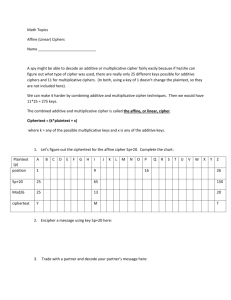CUSTOMER_CODE SMUDE DIVISION_CODE SMUDE
advertisement
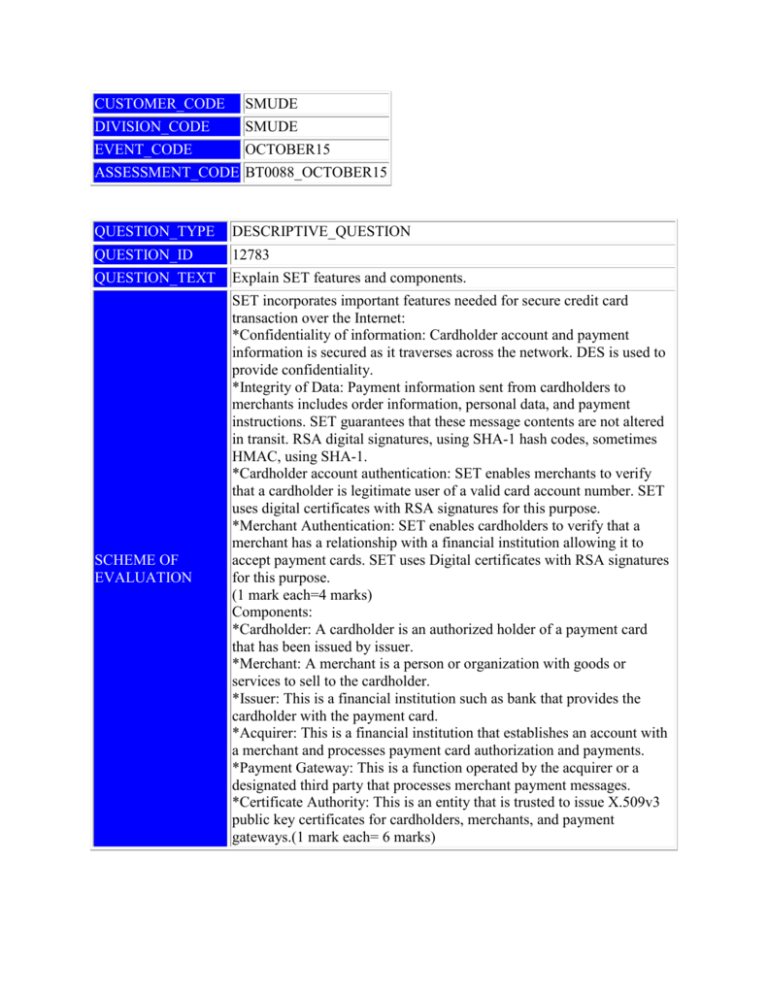
CUSTOMER_CODE SMUDE DIVISION_CODE SMUDE EVENT_CODE OCTOBER15 ASSESSMENT_CODE BT0088_OCTOBER15 QUESTION_TYPE DESCRIPTIVE_QUESTION QUESTION_ID 12783 QUESTION_TEXT Explain SET features and components. SCHEME OF EVALUATION SET incorporates important features needed for secure credit card transaction over the Internet: *Confidentiality of information: Cardholder account and payment information is secured as it traverses across the network. DES is used to provide confidentiality. *Integrity of Data: Payment information sent from cardholders to merchants includes order information, personal data, and payment instructions. SET guarantees that these message contents are not altered in transit. RSA digital signatures, using SHA-1 hash codes, sometimes HMAC, using SHA-1. *Cardholder account authentication: SET enables merchants to verify that a cardholder is legitimate user of a valid card account number. SET uses digital certificates with RSA signatures for this purpose. *Merchant Authentication: SET enables cardholders to verify that a merchant has a relationship with a financial institution allowing it to accept payment cards. SET uses Digital certificates with RSA signatures for this purpose. (1 mark each=4 marks) Components: *Cardholder: A cardholder is an authorized holder of a payment card that has been issued by issuer. *Merchant: A merchant is a person or organization with goods or services to sell to the cardholder. *Issuer: This is a financial institution such as bank that provides the cardholder with the payment card. *Acquirer: This is a financial institution that establishes an account with a merchant and processes payment card authorization and payments. *Payment Gateway: This is a function operated by the acquirer or a designated third party that processes merchant payment messages. *Certificate Authority: This is an entity that is trusted to issue X.509v3 public key certificates for cardholders, merchants, and payment gateways.(1 mark each= 6 marks) QUESTION_TYPE DESCRIPTIVE_QUESTION QUESTION_ID 72789 QUESTION_TEXT Explain the characteristics of following malicious codes: a. Virus b. Worm c. Trojan Horse d. Trap door e. Logic bomb SCHEME OF EVALUATION a. Virus: A virus is a program that can spread the malicious code to other non malicious programs by modifying them. A virus can be either transient or resident. A transient virus has a life that depends on the life of its host; A resident virus locates itself in memory. b. Worm: A worm is a program that spreads copies of itself through a network. The worm spreads copies of itself as a stand-alone program. c. Trojan horse: It is malicious code that, in addition to its primary effect, has a second, nonobvious malicious effect. Contains unexpected, additional functionality. d. Trap door: it is feature in a program by which some one can access the program other than by the obvious, direct call perhaps with special privileges. The trapdoor could be intentional, for maintenance purposes, or it could be an illicit way for the implementer to wipe out any record of a crime. e. Logic bomb: it is a class of malicious code that detonates or goes off when a specified condition occurs. (2 marks each) QUESTION_TYPE DESCRIPTIVE_QUESTION QUESTION_ID 72791 QUESTION_TEXT Explain how cryptanalyst uses different information to break the cipher? SCHEME OF EVALUATION a. Ciphertext only: The cryptanalyst decrypt messages based on probabilities, distributions, and characteristics of the available ciphertext, plus publicly available knowledge. b. Full or partial plaintext: the analyst may be fortunate to have a sample message and its decipherment. In these cases, the analyst can use what is called a probable plaintext analysis. After doing part of the decryption, the analyst may find places where the known message fits with the deciphered parts, thereby giving more clues about the total translation. c. Ciphertext of any plaintext: the analyst might have infiltrated the sender’s transmission process so as to be able to cause messages to be encrypted and sent at will. This attack is called a chosen plaintext attack. For instance, the analyst may be able to insert records into a database and observe the change in statistics after the insertions. Linear programming some times enables such an analyst to infer data that should be kept confidential in the database. This attack is very favorable to the analyst. d. Algorithm and Ciphertext: the analyst may have both the encryption algorithm and the ciphertext. In a chosen plaintext attack, the analyst can run the algorithm on massive amounts of plaintext to find one plaintext message that encrypt as the ciphertext. This approach fails if two or more distinct keys can produce the same ciphertext as the result of encrypting meaningful plaintext. e. Ciphertext and Plaintext: the cryptanalyst may lucky enough to have some pairs of plaintext and matching ciphertext. Then, the game is to deduce the key by which those pairs were encrypted so that the same key can be used in cases in which the analyst has only the ciphertext. (2 marks each) QUESTION_TYPE DESCRIPTIVE_QUESTION QUESTION_ID 72795 QUESTION_TEXT Write a note on i. Cryptographic Hash function ii. Digital Signature Short note on: SCHEME OF EVALUATION i. Cryptographic Hash function ii. Digital Signature 5 marks 5 marks QUESTION_TYPE DESCRIPTIVE_QUESTION QUESTION_ID 118693 QUESTION_TEXT Give the advantages and disadvantages of different types of Encryption System. Ans: Stream Encryption system: SCHEME OF EVALUATION Advantages: 1. Speed of transformation–1M 2. Low error propagation–1M Disadvantages: 1. Susceptibility to malicious insertions and modifications–2M 2. Low diffusion–2M Block Encryption Algorithms advantages: 1. High diffusion–1M 2. Immunity to insertion of symbols–1M Disadvantages: 1. Slowness of encryption–1M 2. Error Propagation–1M QUESTION_TYPE DESCRIPTIVE_QUESTION QUESTION_ID 118698 QUESTION_TEXT Explain the different characteristics of networks. Ans: Each point needs to be explained a. Anonymit:1M b. Automation: 2M c. Opaqueness:3M d. Distance: 2M e. Routing diversity:2M SCHEME OF EVALUATION

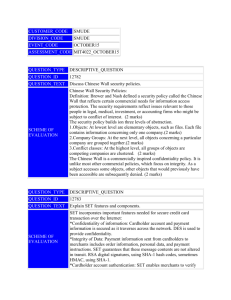

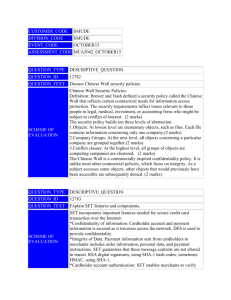
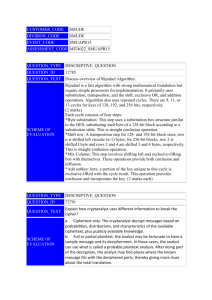
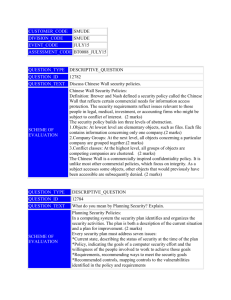
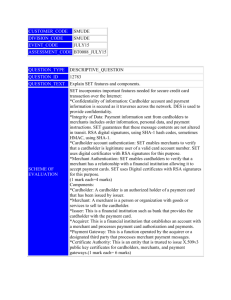
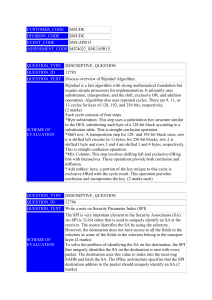

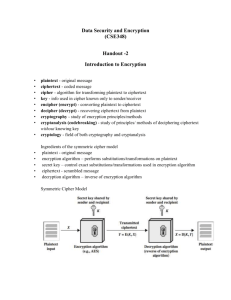

![Problem Set 5 [Word]](http://s3.studylib.net/store/data/006809492_1-3a6588f3420f43040631c60a37bd1b28-300x300.png)
![Problem Set 5 [Word]](http://s3.studylib.net/store/data/006847565_1-b3dd2e0e3ccc871742b0e210e5bf2fd8-300x300.png)
